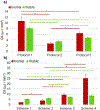Quantifying the Effect of Acoustic Parameters on Temporal and Spatial Cavitation Activity: Gauging Cavitation Dose
- PMID: 37648590
- PMCID: PMC10581030
- DOI: 10.1016/j.ultrasmedbio.2023.08.002
Quantifying the Effect of Acoustic Parameters on Temporal and Spatial Cavitation Activity: Gauging Cavitation Dose
Abstract
Objective: Cavitation-enhanced delivery of therapeutic agents is under development for the treatment of cancer and neurodegenerative and cardiovascular diseases, including sonothrombolysis for deep vein thrombosis. The objective of this study was to quantify the spatial and temporal distribution of cavitation activity nucleated by Definity infused through the EKOS catheter over a range of acoustic parameters controlled by the EKOS endovascular system.
Methods: Three insonation protocols were compared in an in vitro phantom mimicking venous flow to measure the effect of peak rarefactional pressure, pulse duration and pulse repetition frequency on cavitation activity energy, location and duration. Inertial and stable cavitation activity was quantified using passive cavitation imaging, and a metric of cavitation dose based on energy density was defined.
Results: For all three insonation protocols, cavitation was sustained for the entire 30 min Definity infusion. The evolution of cavitation energy during each pulse duration was similar for all three protocols. For insonation protocols with higher peak rarefactional acoustic pressures, inertial and stable cavitation doses also increased. A complex relationship between the temporal behavior of cavitation energy within each pulse and the pulse repetition frequency affected the cavitation dose for the three insonation protocols. The relative predominance of stable or inertial cavitation dose varied according to insonation schemes. Passive cavitation images revealed the spatial distribution of cavitation activity.
Conclusion: Our cavitation dose metric based on energy density enabled the impact of different acoustic parameters on cavitation activity to be measured. Depending on the type of cavitation to be promoted or suppressed, particular pulsing schemes could be employed in future studies, for example, to correlate cavitation dose with sonothrombolytic efficacy.
Keywords: Cavitation behavior; Cavitation dose; Cavitation nucleation; Passive cavitation imaging; Sonothrombolysis.
Copyright © 2023 The Authors. Published by Elsevier Inc. All rights reserved.
Conflict of interest statement
Conflict of interest Boston Scientific provided the EKOS Endovascular System control unit and catheters. C.G. is a former employee and shareholder of Boston Scientific, Inc., and C.K.H. and K.J.H. are consultants with Boston Scientific, Inc. All other authors have no conflicts of interest to disclose.
Figures








References
-
- Chettab K, Matera EL, Lafond M, Coralie D, Favin-Lévêque C, Goy C, Strakhova R, Mestas JL, Lafon C, Dumontet C. Proof of concept: Protein delivery into human erythrocytes using stable cavitation. Mol Pharm. 2022;19:929–935. - PubMed
-
- Somaglino L, Bouchoux G, Mestas JL, Lafon C. Validation of an acoustic cavitation dose with hydroxyl radical production generated by inertial cavitation in pulsed mode: Application to in vitro drug release from liposomes. Ultrason Sonochem. 2011;18:577–588. - PubMed
-
- Bhatnagar S, Schiffter H, Coussios CC. Exploitation of acoustic cavitation-induced microstreaming to enhance molecular transport. J Pharm Sci. 2014;103:1903–1912. - PubMed
-
- Beekers I, Vegter M, Lattwein KR, Mastik F, Beurskens R, van der Steen AFW, de Jong N, Verweij MD, Kooiman K. Opening of endothelial cell–cell contacts due to sonoporation. J Control Release. 2020;322:426–438. - PubMed
Publication types
MeSH terms
Substances
Grants and funding
LinkOut - more resources
Full Text Sources

